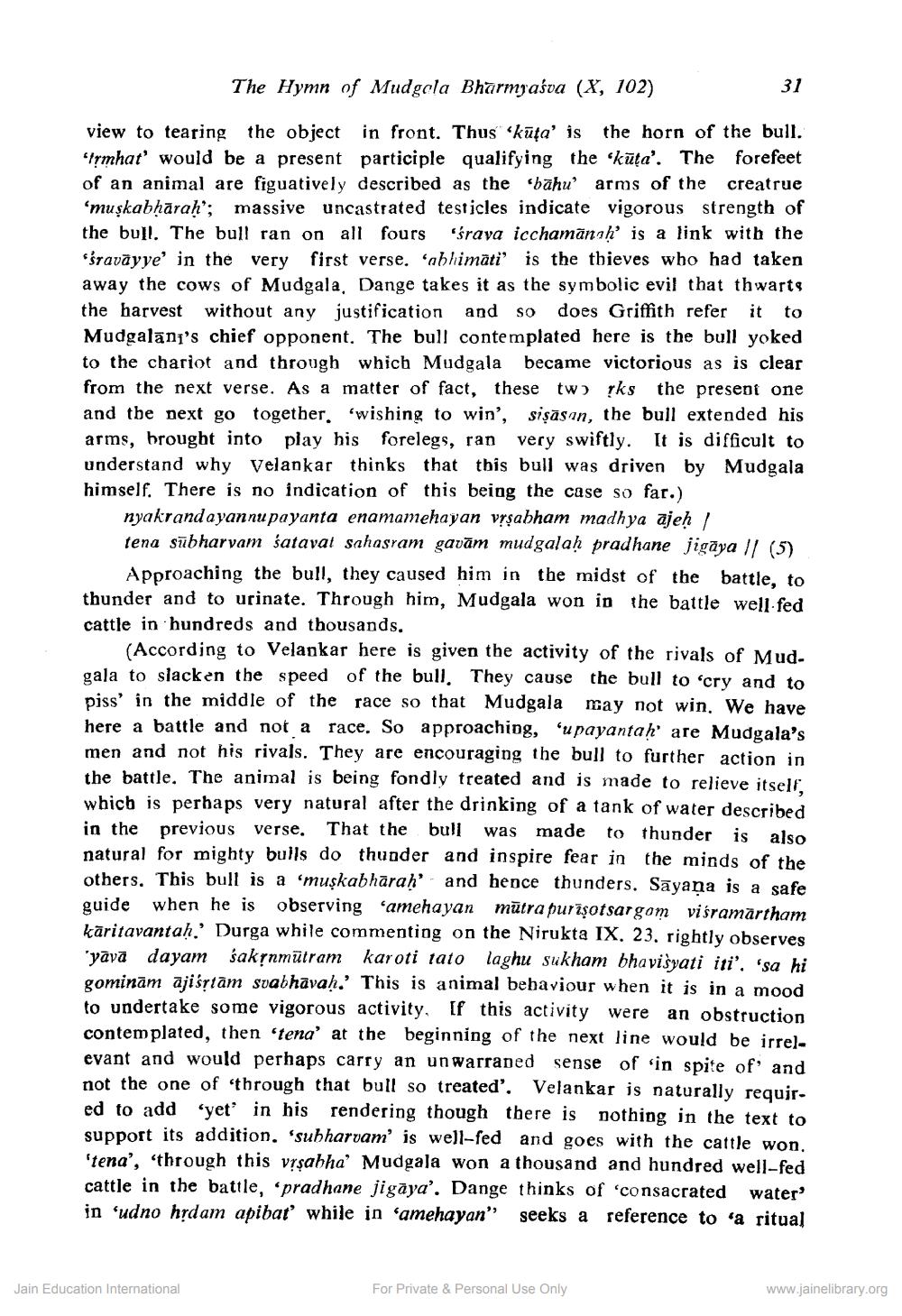________________
The Hymn of Mudgela Bharmyaśva (X, 102)
view to tearing the object in front. Thus 'kūta' is the horn of the bull. "Irmhat' would be a present participle qualifying the 'kuta'. The forefeet of an animal are figuatively described as the 'bahu' arms of the creatrue 'muşkabḥāraḥ'; massive uncastrated testicles indicate vigorous strength of the bull. The bull ran on all fours 'śrava icchamanah' is a link with the 'sravayye' in the very first verse. 'abhimati' is the thieves who had taken away the cows of Mudgala, Dange takes it as the symbolic evil that thwarts the harvest without any justification and SO does Griffith refer it to Mudgalani's chief opponent. The bull contemplated here is the bull yoked to the chariot and through which Mudgala became victorious as is clear from the next verse. As a matter of fact, these two rks the present one and the next go together, wishing to win', siṣasan, the bull extended his arms, brought into play his forelegs, ran very swiftly. It is difficult to understand why Velankar thinks that this bull was driven by Mudgala himself. There is no indication of this being the case so far.)
nyakrandayannupayanta enamamehayan vṛṣabham madhya ajeḥ |
tena subharvam satavat sahasram gavām mudgalaḥ pradhane jigaya || (5) Approaching the bull, they caused him in the midst of the battle, to thunder and to urinate. Through him, Mudgala won in the battle well fed cattle in hundreds and thousands.
31
(According to Velankar here is given the activity of the rivals of Mudgala to slacken the speed of the bull. They cause the bull to 'cry and to piss' in the middle of the race so that Mudgala may not win. We have here a battle and not a race. So approaching, 'upayantaḥ' are Mudgala's men and not his rivals. They are encouraging the bull to further action in the battle. The animal is being fondly treated and is made to relieve itself, which is perhaps very natural after the drinking of a tank of water described in the previous verse. That the bull was made to thunder is also natural for mighty bulls do thunder and inspire fear in the minds of the others. This bull is a 'muşkabhāraḥ' and hence thunders. Sāyaṇa is a safe guide when he is observing 'amehayan mütra purisotsargam visramartham käritavantaḥ.' Durga while commenting on the Nirukta IX. 23. rightly observes 'yāvā dayam sakṛnmütram karoti tato laghu sukham bhavisyati iti'. 'sa hi gominam ajisṛtām svabhavaḥ.' This is animal behaviour when it is in a mood to undertake some vigorous activity. If this activity were an obstruction contemplated, then 'tena' at the beginning of the next line would be irrelevant and would perhaps carry an unwarraned sense of 'in spite of and not the one of 'through that bull so treated'. Velankar is naturally required to add 'yet' in his rendering though there is nothing in the text to support its addition. 'subharvam' is well-fed and goes with the cattle won. 'tena', 'through this vṛşabha' Mudgala won a thousand and hundred well-fed cattle in the battle, 'pradhane jigaya'. Dange thinks of 'consacrated water' in 'udno hṛdam apibat' while in 'amehayan" seeks a reference to 'a ritual
Jain Education International
For Private & Personal Use Only
www.jainelibrary.org




